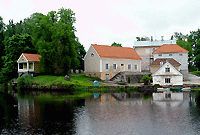Start page

Sitemap




Alphabetical

By parishes and
historical counties

By contemporary
local municipalities




Various meanings
of manor

Types of manors

Manor complex

Estonian manors
|
 |
 |
 |
The word manor has several meanings in modern Estonia.
-
Manor as an economic unit and enterprise.
Historically all manors were large economic units, i.e. enterprises they had their own region of operation, workforce, etc. Such enterprises were private, owned by the state or a town or a person. As a rule, manors were involved in agricultural production, but not only. In the 19th century many manors owed their wealth to vodka distilleries or other fields of production. Some manors consisted only of a single industrial enterprise. For example, the Kärdla broadcloth factory, Joala textile factory and Järvakandi glass factory enjoyed the status of manors.
-
Manor as an administrative unit and territory.
In the 18th and 19th century, all territories outside towns belonged to manors in Estonia. The administrative unit back then was
the parish
with a parish church and parsonage as its heart. The parishes of certain regions formed a county. Parishes were divided into manors. Although parish and manor borders did not always coincide, it was usually still clear which manor belonged to which parish. Normally it was determined by the manor centre or heart, and usually most of the manors lands and villages were to be found in the same parish. Nowadays our addresses contain the name of the county, rural municipality and village/town. Until the 1920s addresses consisted of the name of the parish and manor. As for farmers, the name of the village and sometimes also farm were mentioned.

-
Manor as a building complex (manor heart).
Facilities built for the functioning of a manor as an economic unit were usually gathered at a certain location. This was called the
manor centre or manor heart.
It usually encompassed the main building of the manor - the residence of the landlord or manager/master - and numerous other buildings.
-
Manor as a landscaping object.
The manor centre or heart did not only comprise buildings and park but much more.
 Often the creation of manor hearts lead to substantial changes to the surroundings: rivers were dammed up as ponds and redirected via canals and ditches; imposing bridges were constructed;
slopes were turned into gradually descending plateaus, etc. Often the alignment of roads taking to the manor heart was changed as well. Roads were straightened and turned into avenues by planting trees.
The cemeteries of landlords can be considered another type of landscaping object. Sometimes they were just small graveyards, often with the burial chapel of landlords a small and stylish church building that caught peoples eye. Under the chapel there were usually vaults for burying people.
Often the creation of manor hearts lead to substantial changes to the surroundings: rivers were dammed up as ponds and redirected via canals and ditches; imposing bridges were constructed;
slopes were turned into gradually descending plateaus, etc. Often the alignment of roads taking to the manor heart was changed as well. Roads were straightened and turned into avenues by planting trees.
The cemeteries of landlords can be considered another type of landscaping object. Sometimes they were just small graveyards, often with the burial chapel of landlords a small and stylish church building that caught peoples eye. Under the chapel there were usually vaults for burying people.

-
Manor as a residence (main building).
The most outstanding building of the manor heart was usually the main building, i.e. the residence of the landlord/master. Often the residence occupied the best spot of the holding and served as a landmark for the whole manor complex.
-
Manor as a regional centre of life and culture.
After the land reform in 1919 manors (including the most of manor hearts) were taken away from landowners. As locals had very few buildings that were fit for schools, culture houses and other public buildings, many manor centres came to be used for those purposes. The main building was often turned into a school or culture house and the manor park into a venue for village parties. This is how manors became centres of local life and culture. In the second half of the 20th century when rural areas started to expand manors often became the centre of villages. New houses and public buildings rose around the manor residence and/or park. That was how once elitist and private manor hearts became community centres. This tendency was quite unique in Estonia and Latvia, where massive expropriation of manors took place. This was not the case in countries where landlords were able to keep their estates (e.g. Finland and Sweden). There rural areas developed independently and manors did not have a central role in local life.

|
 |
|
 |
 |









